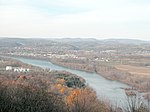Fort Augusta
1756 establishments in Pennsylvania1796 disestablishments in PennsylvaniaAmerican Revolutionary War fortsBritish forts in the United StatesBuildings and structures demolished in 1796 ... and 7 more
Colonial forts in PennsylvaniaForts in PennsylvaniaFrench and Indian War fortsInfrastructure completed in 1756Military and war museums in PennsylvaniaMuseums in Northumberland County, PennsylvaniaSunbury, Pennsylvania
Fort Augusta was a stronghold in Northumberland County, Pennsylvania, in the upper Susquehanna Valley from the time of the French and Indian War to the close of the American Revolution. At the time, it was the largest British fort in Pennsylvania, with earthen walls more than two hundred feet long topped by wooden fortifications. With a garrison of over 300 troops and walls specially constructed to resist artillery, it presented a formidable defense and was never attacked. It served as a refuge for local settlers during the French and Indian War and during the American Revolutionary War. It was abandoned in 1780 and dismantled in 1796.
Excerpt from the Wikipedia article Fort Augusta (License: CC BY-SA 3.0, Authors).Fort Augusta
Nittany Lion Drive,
Geographical coordinates (GPS) Address Nearby Places Show on map
Geographical coordinates (GPS)
| Latitude | Longitude |
|---|---|
| N 40.8757 ° | E -76.792 ° |
Address
Nittany Lion Drive
Nittany Lion Drive
17801
Pennsylvania, United States
Open on Google Maps








